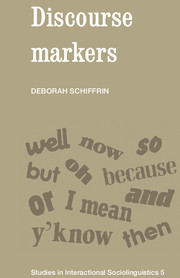Book contents
- Frontmatter
- Contents
- Acknowledgements
- Intonation and transcription conventions
- 1 Background: What is discourse?
- 2 Prelude to analysis: Definitions and data
- 3 Questions: Why analyze discourse markers?
- 4 Oh: Marker of information management
- 5 Well: Marker of response
- 6 Discourse connectives: and, but, or
- 7 So and because: Markers of cause and result
- 8 Temporal adverbs: now and then
- 9 Information and participation: y'know and I mean
- 10 Discourse markers: Contextual coordinates of talk
- Notes
- References
- Author index
- Subject index
Intonation and transcription conventions
Published online by Cambridge University Press: 05 June 2012
- Frontmatter
- Contents
- Acknowledgements
- Intonation and transcription conventions
- 1 Background: What is discourse?
- 2 Prelude to analysis: Definitions and data
- 3 Questions: Why analyze discourse markers?
- 4 Oh: Marker of information management
- 5 Well: Marker of response
- 6 Discourse connectives: and, but, or
- 7 So and because: Markers of cause and result
- 8 Temporal adverbs: now and then
- 9 Information and participation: y'know and I mean
- 10 Discourse markers: Contextual coordinates of talk
- Notes
- References
- Author index
- Subject index
Summary
The role of intonation in my analysis
Although my analysis of discourse markers is primarily an analysis of how particular expressions are used to organize conversational interaction, the impact that a single expression has in conversation may differ depending upon the way in which it is said. For example, oh with a rising intonation might be interpreted as a request for confirmation, as in:
A: I think the party's called for six o'clock.
B: Oh?
But the same expression with a falling intonation might be interpreted not as a request for confirmation, but as an acknowledgement:
A: I think the party's called for six o'clock.
B: Oh.
Because the role of intonation is important, I have paid attention to it in my transcription conventions (see below). I have also discussed intonation when it makes a systematic contribution to the interpretation of an expression. But intonation has not received nearly as much attention as two other factors in my analysis: the expression being used as a marker (its linguistic properties) and the conversational (textual, interactional, etc.) context of the expression. It is my hope that an understanding of these two factors will act as a foundation for a more thorough analysis of the prosody of discourse markers.
Information
- Type
- Chapter
- Information
- Discourse Markers , pp. ix - xPublisher: Cambridge University PressPrint publication year: 1987
